
Amid calls for emissions reductions and net-zero targets, we need a reality check: how are we going to reverse climate change if energy is in everything we do, and energy itself contributes to the problem?
This tool already exists, and it’s nuclear power.
In a talk at South by Southwest this week, Bret Kugelmass, founder and CEO of Last Energy, explained how nuclear power has been misunderstood and devalued for decades, and the price we’ve paid as a result.
“Infinitely abundant, carbon-free, always on, and incredibly energy-dense, nuclear energy could meet and exceed our energy needs,” he said.
He visited 15 countries and all kinds of facilities to learn about nuclear power and compare it to other forms of energy.
His conclusion was that if it’s done right, nuclear can enable continued growth-and a cleaner planet-in a way that no other power source can.
So why did a power source with so much potential stagnate? In 1963, then-President John F. Kennedy said nuclear power would account for half of all US energy production by end of that decade.
His administration put together a perspective for rapid development of nuclear power production, and he had the Atomic Energy Commission conduct a study on the role civilian nuclear power could play in the US economy.
Most of the cost of nuclear energy, he added, is in the interest accrued during the construction process.
The result, unsurprisingly, was that nuclear simply became too expensive to compete with other power sources.
The US is now close to completing its first new nuclear project in decades-and at 10 years late and $20 billion over budget, it’s still not done.
If we had built out nuclear in a viable way starting in the 1960s, we’d live in a very different world today: less pollution, less panic about carbon emissions, more energy security, cheaper end prices for consumers.
Kugelmass founded a non-profit research organization called the Energy Impact Center, which in 2020 launched the OPEN100 project to provide open-source blueprints for the design, construction, and financing of a 100-megawatt nuclear reactor.
EIC’s for-profit spinoff is Last Energy, which aims to connect private investors with opportunities to develop new nuclear projects around the world.
Making nuclear power affordable would mean it could be used for energy-intensive industrial applications that will become increasingly necessary in coming years, like water desalination and carbon removal.
Given our current geopolitical situation and the unsustainable energy costs in Europe, could now be the time for a nuclear revival?
Last Energy is looking to launch in Europe, where the need for affordable energy is dire.
